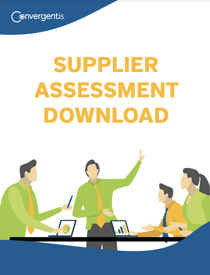One of the most make-or-break decisions procurement teams make in the vendor management process is choosing a supplier. Consider that with the right decision, teams will achieve significant cost savings and may rarely have to make an emergency spot purchase. On the other hand, if they choose the wrong supplier they risk being subjected to high costs, poor quality, and missing deliveries.
Unfortunately, choosing a supplier is easier said than done, often requiring a multi-step process that requires more than simply looking through several price lists. Rather, procurement teams must make decisions based on various criteria, including cost, quality, dependability, communication and service, among others. Moreover, in many cases, your business's priorities (for example, sustainability) and strategy will determine how you should prioritize these various factors.
To help teams navigate this process and optimize their approach, we look at the "how to choose a supplier" process in further detail below.
Comparing Suppliers
The best suppliers are those who provide goods or services that meet or surpass your company's demands. Therefore, it is important to be clear on your company’s specific needs and what you want to accomplish by purchasing from a given supplier.
For instance, suppliers who give you faster delivery would rank higher than those who compete on price alone, all product specifications within tolerance.
Factors Worth Considering
To help guide your decision-making process, we have gathered a list of notable considerations below:
Production Capabilities
First and foremost, teams must find a supplier who can produce the products that they need. This means looking at production capabilities and, from there, determining if the supplier can continue to meet your specs and tight tolerances for the quantity of product you need now and in the future.
Reliability
Reliability is also key. Keep in mind that if your supplier cannot fulfil your order, the ripple effect will hurt the rest of your supply chain and, therefore, your profitability.
Quality
Purchasing organizations are also encouraged to consider the quality of the product or service provided. Without a high-quality standard, your organization runs the risk of providing a substandard product, thereby facing a higher risk of losing customers.
Overall Value
Hand in hand with quality comes the overall value provided. Although it is often enticing to select the supplier offering the lowest price, this might not present the greatest deal. Consider that choosing the right supplier is a balance between quality, quantity and dependability, among other factors. Therefore, making concessions on total value in favour of cost alone might end up hurting your business and what you are hoping to achieve at scale.
Communication
If the Covid-19 pandemic showed the world one thing, it is that nothing (especially the supply chain) is predictable. Therefore, now more than ever, service orientation and a record of reliable communication are becoming increasingly important when determining if a supplier relationship is worth pursuing. Consider that in the event of a major disaster or other supply chain disruption, it becomes crucial for teams to be able to relay information and action plans in a timely manner, thereby reducing further disruptions.
Location
From both a sustainability and reliability perspective, location also comes up as a factor for consideration. Consider that using a local supplier can improve the sustainability of your business since there is less environmental impact to get a product from point A to point B. Additionally, using suppliers that are physically closer can help to eliminate some of the risk that comes with unforeseen transportation challenges such as disruptions to roads or canals. Assuming the capability for production is evenly distributed, avoiding geographically distant suppliers (whenever possible, such as in the case of commodities) can also lead to shorter delivery times and minimized freight costs.
Opportunities for Innovation
Considering these benefits on a deeper level, procurement teams have also achieved measurable success in considering the benefit of a supplier as a partner. By working hand-in-hand for mutual benefit, purchasing organizations have been able to co-innovate closely with their suppliers in developing solutions for mutual benefit, a scenario that comes into play for specialized parts and other high-end goods.
Core Company Values
As you and your supplier begin developing a closer partnership, another factor that will play into your continued collaboration is shared business values. For example, your company might have yearly goals focusing on corporate social responsibility, government mandates and environmental concerns. Therefore, it only makes sense that your suppliers are striving to meet similar goals to avoid backlash stemming from reputational risk.
Financial Stability
Especially true in a specialized component, the financial stability of your suppliers will also come into play. For example, if there is only one supplier of a given product that faces financial trouble, your business may be unable to maintain production. Therefore, many buyers will put into place programs to help their suppliers, such as dynamic discounting or advance payments to ensure that each has its appropriate amount of cash flow and is less likely to go bankrupt.
Wading Through the Shortlist
After going through this initial checklist, teams will likely have a roster of suppliers they can choose from to fulfill their orders. Unfortunately, even those companies pursuing an agile sourcing arrangement, where multiple suppliers are engaged to minimize risk, it is likely that your team will only come to an agreement with one or two of these companies. Therefore, teams must ask:
-
Can the supplier in question deliver what our company wants? At the intervals they need it?
If so,
-
Is the supplier open to discussions on the upside (an agreement that protects purchasing organizations in the event an emergency order is needed)?
Starting Negotiations
Negotiating with suppliers requires careful planning and strategy to ensure favourable terms. Before entering into negotiations, it is crucial to identify the key factors that are most important to your business, such as price, delivery schedule, or payment terms, and establish your non-negotiables. To begin negotiations, clearly communicate the aspects of the deal you are satisfied with and those you would like to discuss further. Avoid revealing early on which points you are willing to compromise on; instead, treat them as leverage to exchange for concessions from the supplier.
During negotiations, encourage the supplier to provide a starting price and disclose any discounts available. It is important to counter their initial offer with a lower offer of your own, prompting the other party to reconsider and propose a revised figure. Additionally, inquire about any additional items or services that can be included at the given price. While price is a significant factor, consider the overall value offered by the supplier. If a price seems exceptionally low, assess the quality of the goods or services and evaluate the level of after-sales support provided. If the deal includes unnecessary features, negotiate for their removal to potentially reduce the price.
Continuous Monitoring
The journey doesn't stop at the selection process. Despite your procurement team doing the necessary due diligence, it is still required to track vendors to ensure they abide by the same criteria listed above in the process of continuous evaluation.
At times, teams will notice a regular cadence of late orders shipped or low-quality of items received, which, if noted early enough, can help teams work together with their supplier for improved outcomes or terminate the contract altogether. In doing so, teams might open the door to working with a new and better supplier.
Building a Successful Vendor Management Strategy
Unfortunately, with so many factors at play, teams are often overwhelmed by the supplier selection process. For this reason, a cohesive portal becomes a critical tool. A portal gives teams a single view into a supplier's history of reliability, costs, and returns (thereby denoting quality).
To help in your assessment, our free guide provides you a step-by-step checklist to help guide the process.


